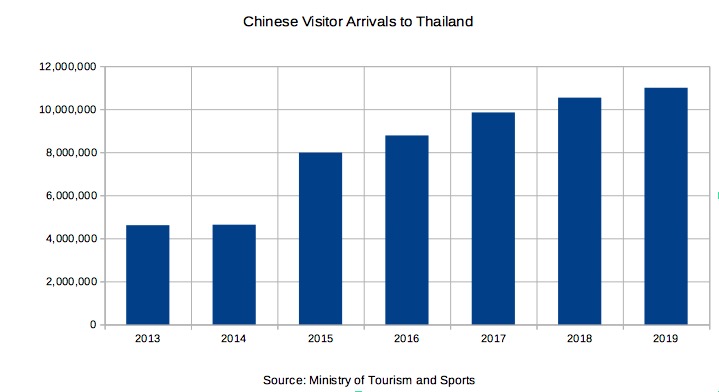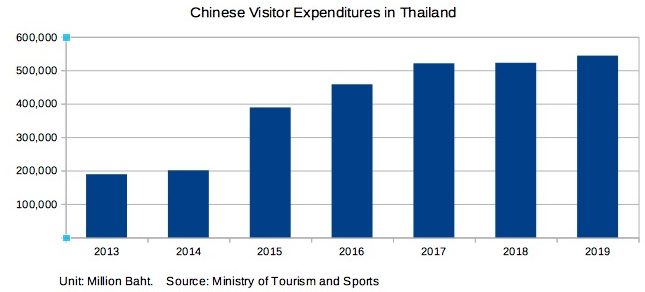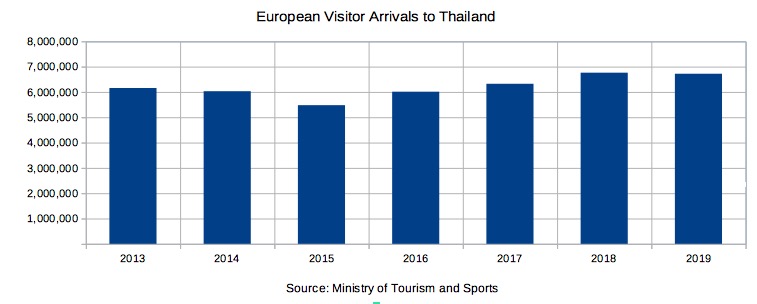
28 Jan, 2020
Thai tourism can convert the short-term coronavirus crisis into a long-term opportunity
Bangkok – There’s nothing like a good crisis to focus the mind. Natural disasters and economic and geopolitical crises also hurt tourism, but none trigger a call to action like a potentially life-threatening health scare. Thailand has experienced, and overcome, many crises over 60 years of tourism history. Although this, too, will pass, it presents an opportunity to fix underlying weaknesses and rebalance, restructure and rebuild an industry which supports 4.5 million jobs nationwide and has put sustainability at the heart of its future development.
Clearly, the 60th anniversary year of the Tourism Authority of Thailand and Thai Airways International is off to a bad start. First came fears of a major geopolitical conflict in the Middle East. Then several days of dangerous air-quality. And now, a health crises. This, in addition to other challenges such as the strength of the Thai baht and heavy-duty competition, including Australia which is also seeking to bring back visitors after the devastating bushfires. Having learnt from previous health crises such as AIDS, bird flu and SARS, Thai health authorities were in rapid-response mode within hours of the first official Chinese announcement. The number of coronavirus cases in Thailand is infinitesimal, but a decline in visitor arrivals for January 2020 over the 3.7 million arrivals in January 2019 is a certainty.
If prevention is better than cure, and seriously draconian measures are required to restrict the spread, similar behavioural change actions are a must in travel & tourism recovery efforts. The biggest mistake will be to go back to business as usual and throw more money at song-and-dance marketing campaigns. Short-term campaigns will certainly be required to save jobs, but they must be balanced by long-term reality-check measures to immunise the country from the next crisis, which is just around the corner.
There is now no disagreement that Chinese tourism grew far too quickly following the 2012 hit Chinese movie “Lost in Thailand.” The 10.9 million Chinese arrivals in 2019 comprise a whopping 27.6% share of total Thai tourism. Assuming nothing would or could go wrong, everyone jumped on the bandwagon. The more businesses were exposed, such as the hundreds of small and medium sized enterprises in Chinatown, the worse they will be hit, especially if the crisis drags on. The risks of over-exposure are now clear.


In the post-crisis recovery phase, one Standard-Operating-Procedure will be to seek out “quick-win” alternative source-markets. The Asia-Pacific region will offer the best potential. Europeans have the highest average length of stay (16-17 days, roughly double the Chinese ALS) but numerical growth from Europe has been anemic since the 2014 military coup. The TAT has shifted towards secondary cities in Europe to target first-time travellers and to niche-markets in the primary European cities to target repeat travellers. But Europe has hit a saturation point and is likely to remain there for many years.

When planning begins for recovery campaigns, the following pointers may help provide a better balanced, broader, more long-term (and alternative) approach:
1. Balance the statistical measurement indicators, especially those related to sustainability. Far too much weight is placed on total arrivals, expenditure, length of stay, demographic profiles and job contribution. Totally missing is an honest accounting of the social, cultural and environmental cost of 40 million tourists and 167 million domestic trips. How much water and energy do they consume? How much garbage do they generate? What is the “leakage” factor – the billions that exit the country to repay foreign loans, marketing and management fees, cost of imports and infrastructure development. How much tax is paid by Thai tourism? Leaving out these critical statistics results in an “imbalance sheet” which looks only at income and turnover, not expenses. That is clearly fraudulent accounting out of sync with a more balanced 20-20 vision.
2. Cap all new licensing until existing businesses are fully recovered. Thailand has more than enough tourism inventory. The recovery period will trigger more cut-throat competition to restore cash flow and repay loans. However, with 50,000 new hotel rooms in the pipeline nationwide, the competition will be intense. Adding new hotels, tour companies, restaurants, etc will worsen the over-capacity crunch and crank up the race to the bottom. The coronavirus crisis is the first this year; it will not be the last.
3. Set up one common, multilingual portal to book everything across the entire travel chain. This project could take at least two years, but a feasibility study would be a good start. Technologically no problem, it could be financially structured as a public-private sector cooperative with an open and transparent administration, free of domination by any one group or investors. The sheer volume of bookings will generate billions of baht which could fund future marketing campaigns, research, industry events, and more. That will reduce the burden on the Thai taxpayer. The customer database generated will also provide valuable demographic and behavioural insights.
4. Provide funds to upgrade travel industry association websites: Thai tourism associations have proliferated in recent years, from restaurants to river-cruises, ecotourism to boutique hotels. Adding to the long-standing associations of hotels, tour operators, MICE, etc., they have their respective agendas and priorities. Many are doing a good job, which they should be communicating professionally via their websites to local and global constituents. Not so. All have poor quality content, especially in English. The prevailing mindset is that a social media network is enough. That may be true for reaching their members, but not for the world at large. As always, the associations plead funding shortages. Offering matching funds to upgrade their websites with very specific RoI targets will help them deliver more meaningful and relevant content.
5. Better balance marketing with funding for management, training and education: The tourism industry spends far too much on marketing. Until the coronavirus crisis abates, those funds could easily be redeployed to training and education programmes within Thailand, especially to upgrade quality of university courses and the technical and language skills of rank and file players (SMEs, guides, security guards, taxi-drivers, etc). Plugging this important deficiency will help Thai tourism upgrade the industry “software” in an era in which quality of service and the image of “Thainess” will be a primary determinant of reputation.
6. Hold a major tourism summit and UN-style public hearings. Thailand has no annual tourism industry summit. This shocking deficiency is a major reason why the industry has grown fat, not fit. Everyone does their own thing. Private agendas are followed with no opportunity for debate and discussion nor any exposure to wider regional or global contexts. Current industry forums are heavily dominated by CEOs, with scant representation by grassroots actors such as unionists, local communities, civil society, etc. The UN Sustainable Development Goals may seek to “Leave No One Behind’ but that will be a pipe-dream if those who face the greatest risk of being left behind are denied a voice and a seat at the table.
7. Advance the expansion into new markets in Africa and Latin America. The Thai Foreign Ministry and Commerce Ministry have a definitive policy to expand Thailand’s “soft-power” profile and identify future markets for Thai agricultural and manufactured products. In recent years, the TAT has begun to invite more potential buyers from Africa and Latin America to its trade shows. But it is only scratching the surface. Airlines such as Varig Brazilian Airlines and South African Airways once had direct flights to Thailand. Thai Airways International once had direct flights to Johannesburg. Airlines such as Ethiopian and Kenyan Airways fly to Bangkok but use it more as a hub for connections from China and the region. More point-to-point traffic would be a logical step up.
8. Convert the Visit Malaysia Year 2020 and the TAT-TG 60th anniversary celebrations into a joint ticket. Malaysia is Thailand’s second-largest source of visitor arrivals after China. However, as a neighbouring cross-border country, it is of far greater strategic and geopolitical importance. There is enormous potential for developing that entire area between Southern Thailand and Northern Malaysia for tourism. It would also serve a wider agenda to forge an Alliance of Civilisations between Buddhism and Islam. That will reduce the influence of extremists in both faiths and send a message to other countries in Asia, such as India and Myanmar.
9. Promote ASEAN Identity. In 2019, Thailand was chairman of ASEAN under the slogan, “Advancing Partnership for Sustainability”. The well-planned year resulted in two major summits and a number of multi-sectoral deliverables, nearly all of which have a linkage with travel & tourism. As 2020 has been declared the Year of ASEAN Identity, this could be a good opportunity to put some wind into the sails of that declaration. In future, the ASEAN market is going to be one of the strongest alternatives to reduce and rebalance Thailand’s dependence on Chinese tourists.
10. Promote Muslim travel. In 2015, the TAT launched a campaign to promote Thailand as a Muslim-friendly destination. Since then, the campaign has fallen of the radar screen. The Islamic world is another promising alternative to the Chinese market. In addition to the ASEAN countries of Indonesia, Malaysia and Brunei, there is enormous potential for attracting more well-heeled visitors from Bangladesh, Pakistan and the Muslim minorities in countries such as India and South Africa. The numbers may be small, but they are high spenders, as is obvious from the number of Bangladeshi patients in Bumrungrad hospital.
Conclusion
If the Chinese outbound market slumps, there is zero chance of Thailand’s 41 million arrivals target for this year being met. In fact, Thailand could face its first arrivals downturn since 2014. That would make it a good time to adopt the famous Chinese dictum: Within every crisis lies an opportunity. Short-term pain is a foregone conclusion, given the current circumstances. Converting it into long-term gain would be the best possible option.



Liked this article? Share it!